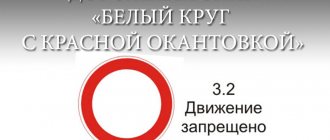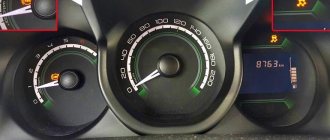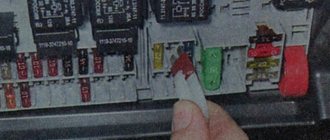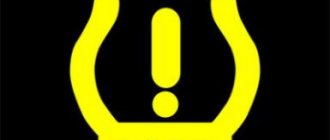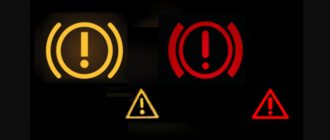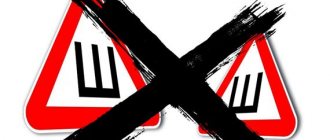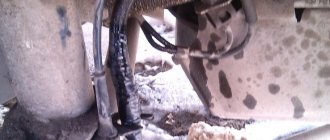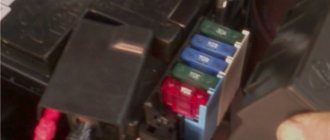It is known that the carriageway along its length in different places may have different widths sufficient for traffic. Depending on the organization of traffic along the lanes, the nature of road intersections (junctions, road junctions, etc.), the type of engineering structures (bridges, overpasses, tunnels, etc.), as well as temporary road works, both expansion and contraction can be observed roadway.
In places where the width changes, appropriate road signs are installed, or not installed if their absence does not cause ambiguity in the interpretation of the road situation.
What does the “Narrowing Road” sign look like and what does it mean?
- on right;
- left;
- at both sides.
Depending on the type of narrowing, a corresponding sign is installed to warn drivers that some of them, depending on their position on the road, will need to change lanes or give way to another car. This is necessary in order to maintain order on the road, so that drivers clearly know what to do and no dangerous emergency situations arise.
The narrowing itself can be temporary or permanent, depending on the situation. There are some areas where it was impossible, for one reason or another, to build an equally level road with a standard width. Therefore, such a sign is installed on a permanent basis in these areas. But, in most cases, such signs are installed temporarily on normal standard roads, for example, if repair work is underway there. Since it is not always possible to block all traffic on the road during repair work, only part of it is closed, one lane, and the other is left so that drivers can pass. And so that drivers know in advance that repair work is underway in this area and the road is narrowing, appropriate signs are installed. If the sign is temporary, it will be yellow.
In addition to installing a road sign “Narrowing of the road”, it is also necessary to install a sign notifying about road work. After the work is completed, both signs are removed.
If the sign is permanently installed, then in populated areas it is installed at a distance of 50-100 meters, outside populated areas - at a distance of 150-300 meters.
In large cities, such signs are located in areas where there are public transport stops. The signs are there permanently so that buses, trolleybuses, minibuses and other types of public transport can stop, disembark and pick up new passengers without interference. And ordinary cars will not interfere with them at this moment.
Rules for such a maneuver
The procedure for simultaneous and single changes of cars from row to row is regulated by paragraph 8.4 of the traffic rules.
It contains the following requirements.
- If a car is driving in the right lane and wants to continue driving in the left lane, the driver must make sure that his maneuver is safe and turn on the appropriate turn direction indicator light. Moreover, if another car is driving on the left (interference on the left), then it has priority. It follows from this that the obstacle on the left must be passed forward, and only after that, after making sure it is safe, carry out the above maneuver.
- If a car is moving in the left lane and wants to change lanes (make a maneuver) to the right lane, then the driver must turn on the turn signal and make sure that there is no obstacle on the right (another vehicle), and then move. In this case, the car that is driving in the other lane (obstacle on the right) has the advantage, so you need to let it pass, and then just carry out the maneuver.
Such rules are established so that you can safely change lanes. This is not a difficult maneuver, but it requires maximum attention from the driver and the choice of a certain speed limit.
In addition, drivers must carefully monitor the road situation and choose the optimal speed limit. That is, even if someone violates traffic rules and creates an emergency situation, they should try to avoid an accident by correct maneuvering.
Features of the “Give Way” family signs
Like most other warning signs, signs indicating a narrowing of the roadway are triangular in shape with a white background and a wide red border around the perimeter. Inside the sign there are pictograms of two stripes. If the taper is on both sides, both stripes will be curved with a taper at the top. With a one-sided reduction, one of the stripes will be straight, and it will be located on the side where the narrowing is not expected. This designation is intuitive and means that if you are driving from a straight lane, you have the right of way because you are moving straight.
If the road narrows on the left side, this means that traffic moving along it will have to change lanes to the adjacent right lane, and vice versa. If a two-way narrowing is expected, both the left and right columns will have to change lanes to the central lane.
In any case, those drivers who are driving in the lane to which they need to change lanes have an advantage. In most cases, the interpretation of this family of signs does not cause ambiguous interpretation.
Varieties of the “Narrowing Road” sign
What does the sign mean
Sometimes the fact of a reduction in road width, an actual reduction in the number of lanes, can (quite often) be ambiguous and it turns out that one warning is not enough. This decoding is intuitive and means that when driving from the straight lane, there is an advantage to passing, since you are the one moving straight.
Usually the interpretation of this group of signs does not cause confusing interpretation if you know the theory. In any case, it is worth remembering that one or more directions of traffic will soon disappear and it is necessary to change lanes in advance. When performing this maneuver, according to paragraph 8.4 of the traffic rules, you should give way to other cars moving more steadily.
What it looks like and what it is intended for
The warning about the narrowing of the road includes several variations at the same time (1.20.1 - 1.20.3), but they all have a similar design: in the red triangle, 2 roads are depicted with black lines, one of which symbolically shows the change of lane. And if the narrowing is planned to be double-sided, then both stripes will be curved and narrowed at the top of the sign.
In combination with other markings and similar signs, these tips significantly help the driver navigate the road if he is driving where there is a shortcut. Due to the wide variety of scenarios, the rules provide for the presence of a whole family of such signs that indicate narrowing:
- in parallel - 1.20.1;
- right - 1.20.2;
- on the left - 1.20.3.
A priori, there can be several reasons for the narrowing of the road: a change in the path in front of a narrow section (bridge, tunnel, overpass, etc.), repair work, an acceleration lane after merging roads and junctions.
Moreover, an unexpected narrowing of a particular section of the road may turn out to be a permanent phenomenon. In this case, it is directly related to the natural features of the relief. Although much more often such signs can be found in certain areas of the highway where repairs or other restoration work are being carried out. Then they try to avoid a complete blockage of traffic without complicating the situation on the roadway.
To figure out whether the sign you see is temporary or not, you can take a closer look at the background - for a non-permanent limitation, the fill in the picture is made yellow, and after the reconstruction is completed, it is removed. But in addition to the “Narrowing of the road” sign, often in such cases an additional sign is also installed indicating that repairs are being carried out on the tracks: it obliges car owners to increase concentration and reduce the speed of the car when entering a problem area.
In what cases is it necessary to install such a sign?
The “Narrowing Road” sign in any of the mentioned variations can be found in the city and beyond. Typically, the sign is installed where the total number of lanes decreases: in order to continue driving, motorists must clearly know how to change lanes without violations and safely overcome a specific section of the road . For example, the sign can be found:
- In a populated area, at a distance of 50-100 m to the place of narrowing.
- Outside the populated area, 150-300 m before the road change zone.
- Next to signs 1.25 “Road works” or 4.2.1 - 4.2.2 “Avoiding obstacles on the right and left”.
- Near the designations 5.15.5 - 5.15.6 “End of lane”, as well as at the end of an additional lane on an ascent or acceleration.
It is often accompanied by vertical road markings. At the same time, in places with an active flow of traffic, group signs are fixed near public transport stops: this makes it possible to stop without problems to pick up/drop off people.
An equally good place to install the “Narrowing Road” sign is in front of bridges and road junctions. In the second case, the best example is the entry zone from a minor highway to the central highway. This initially implies the presence of an acceleration lane, which then connects to the main road. But, given that when designing roads it is worth reducing the total number of turns (the road should be clearly visible), various imperfections in the terrain often force us to deviate from this requirement.
Varieties of sign
Here we are talking about signs 1.20, of which there are actually 3. And they have slightly different appearances, installed in appropriate situations. In the photo you can clearly see the difference.
The point of the sign is that two lanes merge into one. The only question is that there is an acceleration lane, and there is another narrowing lane. That is, they move straight along one, and perform a maneuver along the other. But there is an exception in the form of the third sign, where the maneuver is provided from two lanes at once, which begin to narrow. I think it is about this sign that the greatest number of disputes and conversations arise.
As for the signs themselves, they are presented in the form of a red triangle with a white background. The background can also be yellow, which means the sign is temporarily located in this area. They are installed during repair work.
When the repair is completed, the structure is removed and it ceases to function.
But the image inside the triangle comes in 3 types. Hence the division into subcategories of the sign.
- 1.20.1. Such an indicator is presented in the form of the same triangle, inside of which 2 black stripes narrow. From expansion begins contraction. This means that change occurs on both sides;
- 1.20.2. Here the left black stripe remains straight, and the right one is curved. I think it’s not difficult to understand that the narrowing occurs on the right side;
- 1.20.3. The situation is the opposite of the previous one. The left stripe is straight, and the right one tapers.
There are different signs on the roads. From them, the driver can understand in advance that there will be a narrowing ahead. Moreover, some motorists must change lanes or yield to other drivers, depending on where they are moving and in which lane.
This makes it possible to regulate the flow of cars on sections of roads that narrow.
The narrowing can be permanent or temporary. In the first case, the pointer will have a white background, and in the second, yellow.
Signs are located at a distance of 50 to 100 meters from the narrowing itself, if it is located within a populated area. Outside populated areas, according to the rules, the sign must be placed at least 150 and maximum 300 meters away.
There are also large cities where such signs are located specifically at public transport stops. According to traffic regulations, drivers do not have the right to enter there, since this is a designated area for public transport where passengers pick up and drop off. A smart solution for security purposes.
Who gives way if there are no road narrowing signs?
In cases where the roadway narrows, and there are no road signs warning about its narrowing (and there are many such cases), then the principle of observing priority is the same as if “narrowing of the road” signs were installed.
The circumstances are similar to those that arise in areas of road narrowing indicated by signs, with the slight difference that the narrowing of the roadway itself has to be “calculated” visually.
The driver on whose side the road narrows cannot move further in his lane; he is forced to change lanes. And in this case, the requirement of paragraph 8.4 of the traffic rules comes into force: if one moves without changing its direction of movement, and the second changes lanes and their paths intersect, then the one who changes lanes gives way.
If, however, in a place where the roadway narrows, regardless of the presence of signs “End of lane” or “Narrowing of road”, an accident occurs, then the main culprit will be the driver who was obliged to give way (the one who changed lanes; in case of both lane changes - the one who was driving on the left ). The degree of guilt of the other participant in the accident will be determined at the scene of the event.
Lack of signs and markings
The situation is not uncommon when there is a narrowing, but it occurs without a sign or marking. This is a huge flaw in the responsible services.
If you doubt the correctness of your actions, if there are no signs and markings, just imagine that they are there. This will make it easier to make the right decision.
You should not rely on the fact that due to a missing sign you can violate the rules of the signs in question and the traffic priority rule if you are fined or you become the culprit of an accident. So, this may somewhat influence the court's decision. But at the same time, even the absence of a sign or markings does not relieve one from responsibility for failure to comply with the rules on the need to give way to passing vehicles that do not change their direction.
Subscribe to updates and receive articles by email!
We guarantee: no spam, only new articles once a week!
Good afternoon, dear car enthusiasts!
In this material we will consider the issue of priority when narrowing the road. With proper organization of traffic, the narrowing of the road is indicated by appropriate signs and markings, however, in practice, it is not uncommon for drivers to find themselves in a “neck” in the absence of means of organizing traffic.
For example, take the narrowing of the road at a bend.
Cars moving in two rows in the same direction are forced to divide the remaining lane among themselves. There are only two options, either the white car is inferior, or the blue one.
Basically, for this situation, drivers apply one of two points of the Rules of the Road.
Some people consider this a rebuild:
8.4. When changing lanes, the driver must give way to vehicles moving in the same direction without changing direction. When simultaneously changing lanes of vehicles moving in the same direction, the driver must give way to the vehicle on the right.
For others, this situation is not regulated by the rules and they apply clause 8.9 of the traffic rules:
8.9. In cases where the trajectory of vehicles intersect, and the order of passage is not specified by the Rules, the driver to whom the vehicle is approaching from the right must give way.
Arguments for gaining an advantage from a white car: “I’m moving in the left lane, there are no obstacles in this lane, I’m not maneuvering, I’m not changing lanes, the blue car is changing into the left lane.
Arguments for gaining an advantage for the blue car: “The road is narrowing, two lanes end, only one remains and both cars simultaneously change lanes into this remaining lane” or “In this case, the order of passage is not specified by the rules, and the one with the obstacle on the right gives way "
It turns out that both cars have the right to count on an advantage, but this cannot happen. Therefore, let's analyze this road situation in detail. First, for convenience, we will “straighten” the road, since the bend itself has no direct relationship to the number of lanes on the road. From the point of view of the Road Traffic Rules, driving along a curved road is straight. All direction changes are made relative to the direction of the road. The fact of narrowing is important, but the narrowing along the radius or along the straight line does not matter.
Road narrowing signs on the right, left, on both sides
The sign itself is triangular in shape. This is a red triangle on a white background, inside of which there are two stripes. Depending on how narrow it is, one or two stripes will be crooked. For example, if it is a narrowing on the left: on the right side the black stripe on the sign is straight, and on the left side it is curved. If the narrowing is on the right, the opposite is true. If it is narrowing on both sides, both black stripes are crooked. The signs are quite simple and the driver, even if he suddenly forgot what they mean, should be intuitively clear.
Depending on which side the narrowing is on, some motorists will need to change lanes. If it is a narrowing on the left, those driving from this side will have to change into the adjacent lane on the right, if on the right - vice versa. If there is a sign indicating that the road is narrowing on both sides, you will need to change lanes to the middle lane.
But when performing this maneuver, you should be very careful. You need to give way to those driving in the lane into which the driver plans to change lanes. This is necessary so that everyone can travel without delays and there are no collisions, which will certainly lead to serious congestion and traffic jams. To prevent such problems from arising, there are rules that all drivers without exception should follow.
Fine for violating traffic rules when passing a “Narrowing road” sign
Drivers are different. Some are disciplined, others allow the possibility of minor violations. Some are always concentrated and extremely attentive, others rely on intuition, constantly talking on the phone or with passengers. Some have an instant reaction that allows them to get out of the most dangerous situations unharmed, while others need a little more time to correctly navigate a difficult traffic situation.
If everyone were the same, there would most likely be no traffic accidents. But the reality is that none of us is immune from making mistakes, including those related to the rules for driving sections of the road on which the “Narrowing of the Road” DZ is installed. There is no need to talk about the seriousness of the punishment for such offenses - according to Article 12.014 of the Administrative Code, it involves the imposition of a standard fine (500 rubles). Unfortunately, this does not provide any significant incentive for drivers to strictly observe the order of travel in controversial situations.
How should you change lanes when the road narrows at the same time, and who should give way?
The situation is somewhat different when the road narrows at the same time, and who should give way in this case is considered according to a different principle. The rule is that a driver changing lanes must give way to those moving without changing direction, i.e. in a straight line, applies only to cases of, say, three-row traffic with the middle row moving straight. If we are talking about drivers who simultaneously change direction, as warned by the sign “Narrowing on both sides,” then you need to remember the right-hand rule and give way in favor of the car that is moving on the right.
When is it okay not to give way?
You may not give way in the following cases:
- at an unregulated intersection when moving along the main road (except for pedestrians who have entered an unregulated pedestrian crossing);
- at a controlled intersection when moving on a green light in the forward direction (except for a tram, also moving on the main green light);
- at the intersection of equivalent roads if you intend to turn right (except for pedestrians) (there is no need to yield, since there is no obstacle on the right);
- when the road narrows, you do not need to yield if you continue to move in your lane without changing direction.
Varieties and features of signs of this group
Warning sign 1.20 called “Narrowing of the road” can be found quite often, both within the city and on highways. One glance at the characteristic triangle is enough for even those ignorant of these matters to intuitively understand its meaning. There are three varieties of it:
- narrowing on both sides (1.20.1);
- narrowing on the right (1.20.2);
- narrowing on the left (1.20.3);
According to the rules, signs of this group are installed at a distance of 50 to 100 meters before the start of a dangerous section (if the road passes within the city) or within 150-300 meters (on country roads).
When does it become necessary to install “Narrowing Road” signs?
As already noted, in large cities such remote sensing can most often be seen when approaching a public transport stop. True, this is not necessary, but the combination of two signs attracts the attention of drivers more than a single sign - perhaps the traffic police are guided by this.
Temporary signs are installed not only in road work areas. Surely you have repeatedly encountered situations when, due to an accident, a traffic jam arises due to the need to bypass the injured vehicles. In such cases, a temporary sign is also installed to warn drivers of the need to change lanes soon.
When constructing suburban highways, traffic intensity in different areas is usually carefully studied. It happens that before turning to a large populated area the traffic is very dense, and after it it thins out significantly. In such cases, it makes no sense to spend money on extra lanes that will remain unused, so the road becomes narrower, as the corresponding sign will warn about.
Another common place for installing the “Narrowing Road” remote control is in front of bridge structures and road junctions. In the latter case, the most typical example is the entrance from a minor road to the main highway. Typically, in such cases, an accelerating lane is provided, which then merges with the main one.
It is not uncommon to install an LED sign before an intersection if the road after it is less in demand and does not require a large number of lanes. Many drivers, seeing such a sign, try to change lanes in advance, which often leads to conflict situations. But this is better than driving through an intersection in a lane that will be leveled - you simply may not have the time and space to change lanes, which could result in a collision with oncoming traffic.
Interference on the right when turning and driving through intersections
At the exit from large populated areas, as well as in the center of some smaller urban areas, unregulated intersections are very common. There are 2 types of them: unequal and equivalent intersections. But how should we proceed in this case?
Equivalent intersections
The driver of a trackless vehicle, in this case, can fully use the right-hand rule, having previously let the rail vehicle pass. The obstacle on the right when turning is taken into account by all traffic participants in this section. We have previously written in detail about the passage of vehicles at unregulated intersections.
Uneven intersections
For convenience and correct passage, you should first study the road signs when approaching the junction. The first to leave such a section are the rail workers located on the main road. Next are trackless vehicles that are on the main road (when crossing, we use the right-hand rule). Only then can participants on the secondary road pass each other in the same order (first rail vehicles, then trackless vehicles).
Legal assistance in case of violations and accidents
Road disputes are one of the most common today; drivers often get confused due to the installation of contradictory signs, misunderstand the rules and find themselves in difficult situations due to a number of additional nuances. As practice shows, all cases are individual and therefore require detailed consideration from a legal point of view. Therefore, if you get into an accident or disagree with a traffic police officer who has accused you of a violation, it would not be a bad idea to seek help from a lawyer specializing in motor vehicle law issues. He will help you understand the situation and find the right way to resolve the issue.
Is it possible to challenge a fine?
Modern drivers are more educated than their colleagues 20-30 years ago, so they easily enter into disputes with representatives of law enforcement agencies responsible for enforcing traffic rules. We recommend doing this only in cases where you are absolutely sure that you are right. Situations with passing SD signs are interpreted quite unambiguously, so here your chances of avoiding punishment in the event of an obvious violation are minimal. The traffic police officer is not obliged to inform you that your violation was recorded by appropriate technical means, so you take a big risk by filing an appeal. We do not encourage you to negotiate on the spot, especially since this violation is subject to the law on a twofold reduction in the amount of the fine, provided it is paid within 10 days. In any case, the fine is not so large as to require an auto lawyer to get involved. Just try not to break the Rules in the future.
vote
Article rating
In what cases can you encounter such a sign?
There may be several such situations. The most common reason in cities is public transport stops. They are not always marked with this sign; they usually make do with road markings. But there are other unobvious reasons that are difficult to predict on your own. For example, you are driving along a spacious avenue, but then you see a sign that the road will narrow after the intersection, and you are almost at the traffic light, it is almost impossible to change lanes, and after passing this place there will be no more time. In this case, you will have to stay a little longer and wait until they give way to you in the adjacent lane, since you are not in a dominant position, but you cannot move insolently towards the narrowing.
Also, a decrease in the width of the roadway occurs after turning from a minor road onto a wide expressway, where an acceleration lane is provided to wedge into fast traffic, but then it disappears, and you need to have time to change lanes, but at the appropriate speed. Often the road changes the number of lanes in front of structures, for example, a bridge can serve this purpose. Moreover, the usual economic frugality of the “road builders” must not be forgotten; sometimes the road narrows simply because the extra lane is unnecessary, because there is not enough congestion on the route.
You can also see a yellow sign with similar content, i.e. temporary, most likely, you find yourself near a road repair site, so the lane is temporarily taken out of circulation, and you are forced to change lanes.
There is a narrowing of the road ahead - who should give way?
We have considered the situations when you will have to deal with this sign, but what to do when there is a narrowing of the road ahead, who should give way when maneuvering - the neighboring stream or you? Let's think about this topic. Of course, you are the injured party, but this is not the fault of the passing traffic, which is going in the same direction as you at a confident speed of 60 km/h, and even more outside the city. Therefore, the traffic rules state that in any situation you must yield to passing traffic (cars walking nearby in the same direction as you).
However, it's not all doom and gloom, and you won't have to wait for all the city's cars to pass along this road. If a traffic jam forms from the lane that disappears ahead, then you will be gradually let through from the adjacent passing lane, guided by the same traffic rules, only not all at once, but one car at a time. There is also a driving ethic in which other road users try not to tightly occupy the lane that is adjacent to the narrowing one, so that all cars can change lanes in time. Sometimes, of course, this is not entirely possible, for example, all at the same intersections, then you need to be patient and not be offended by other participants, and in the future, plan to change lanes long before the unfortunate narrowing.
Directions.
The Traffic Rules do not limit directions to driving straight ahead - this is important. There are four directions of movement:
- Directly
- Right
- Left
- Reverse direction
The next important point is that the direction of movement is determined relative to the direction of the road. If a road physically changes direction, then the direction of travel on that road does not change. Driving on a winding road is, within the framework of the Road Traffic Regulations, driving straight. For example, there is no need to turn on your turn signals, stay in an extreme position, or comply with other regulations related to maneuvering, because you drive straight regardless of changes in the actual direction of the road. You are moving along the road. Where the road goes, so do you.
Please note: In the text of the rules, the same concepts can be used both in the generally accepted understanding and in accordance with the definitions. For example:
A turn is a maneuver described in Chapter 8 of the rules as a change in the direction of movement on the roads and a turn in the generally accepted sense, indicated by the signs “Dangerous turn” or “dangerous turns”, as an actual change in the direction of movement.
Stopping is an action defined by the Rules of the Road, and an actual stop when the speed of movement becomes zero (in a traffic jam or in front of a traffic light). The same goes for directions.
How to avoid an accident on a narrowing road
In places where the road narrows, there is always the possibility of a side collision with a fellow traveler who is driving parallel in the next lane or in the next row.
To avoid getting into an accident where the roadway narrows, you should look at the road several cars ahead and prepare to change lanes in advance, monitoring the situation around your car. Most often, the road narrows on the right side, but if road work is underway on the roadway, it can be narrowed on any side of this direction.
In road construction sites, side barriers are often installed in narrow areas. Therefore, in order to avoid an accident, it makes sense not to accelerate at the entrance to such a site.
The “End of lane” sign is usually visible from afar, and “Narrowing of the road” warning signs are installed in advance (outside the populated area 150-300 meters, in the populated area - 50-100 meters before the narrowing). Therefore, it is possible to get your bearings in advance.
The method of changing lanes (early or late) will have to be chosen, as they say, during the movement, depending on the traffic density of cars that will develop at that moment in time.
If you are moving next to a lane that is narrowing or ending, then you need to carefully monitor the “neighbors” who have begun to change lanes. It happens that the process of rebuilding them begins late, and happens roughly, as if forcing fellow travelers to slow down and let them into their lane.
For this reason, it makes sense to constantly monitor the lateral interval to the cars next to you, and be prepared, if something happens, to take measures to prevent an accident (use a sound signal, brakes to help).
In such cases, there is no universal advice on what to do. Each specific situation has its own “nuances”. But you can only see them by monitoring the situation around your car.
Who must give way if there is a narrowing on the right?
The problem of the question for many is due to the fact that drivers are accustomed to being guided by the principle of the “right” hand, but here we should not forget that the rule “Interference on the right” applies exclusively to intersections, but does not apply in any way to those who are moving parallel, in the same direction in a straight line road surface. Thus, a car that finds itself in the right lane, which, according to the sign, will disappear in a few meters, needs to slow down and let the passing traffic pass, which is absolutely not to blame for the problem that has arisen with your row.
At the same time, such a requirement does not mean that cars that find themselves on a “disappearing” road will have to wait indefinitely until the entire flow of cars in the adjacent lane ends. The rules of the road apply when, as soon as congestion begins to form on the narrowing side, drivers moving in the remaining lane must allow neighboring cars into their lane. Of course, not all at once, but one by one.
Carefully! Often, drivers, not wanting to waste time, move along the narrowing lane until the last meters, and then get stuck waiting for a long time, trying to fit into the next row. You should not rely only on the Rules and driving ethics; it is better to change lanes in advance.
Tapering options
The driver’s actions in a situation with the signs in question directly depend on which side the narrowing will occur.
- If the situation narrows on the right, that is, the right lane on the sign is curved, then those moving along this lane, that is, on the right, are required to change lanes. They should carefully move to the left;
- If the narrowing is on the left, then on the contrary they will have to go to the right;
- When the situation forces you to narrow on both sides at once, the transition is simply to the middle lane.
During the maneuver you should be extremely careful and careful. Are you moving from your lane to the next one? Then it is the adjacent lane that is now the main one, and you must give way to drivers moving along it.
If, in accordance with the sign, your lane does not narrow, but the neighboring one does, then you must be allowed to pass on the left or right, depending on the type of sign installed.
Bilateral narrowing involves the use of the same rules and principles. Whose streak ends first is the one who misses.
Installing a Chinese din radio in a car: how to do it yourself
But sometimes changes in the width of the road surface on the right or left force you to wait for a long time, allowing motorists to pass in the priority lane. If it is a busy highway with huge traffic jams, according to the rules you will still have to wait. But there is a concept of driver ethics. It provides that the driver can stop, letting cars pass from the narrowing lane, in order to relieve the situation a little. If you are missed in a heavy traffic, don’t forget to say thank you. This is done extremely simply by turning on the emergency lights for a few seconds.
I think there is nothing complicated here. Those who remain in their lane calmly continue moving, do not wait for anyone and do not let anyone through.
When there is a narrowing in your lane, you wait and let it pass. Everything is elementary.
